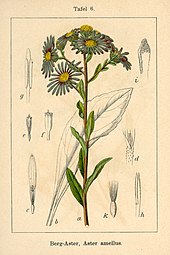Asterids

The asterids are a group of flowering plants . They are one of the two large groups within the eudicotyledons . According to the systematics of the Angiosperm Phylogeny Group , they are a clade without taxonomic rank and roughly correspond in size to the earlier subclass similar to asters .
features
The asterids are essentially characterized by molecular genetic features, there are only a few common morphological features. Their flowers are usually five-fold with a calyx and fused petals . Often there is only one stamen circle . The gynoeceum is fused (synkarp), the number of carpels is reduced in many groups. The ovules have only one integument and are tenuinucellate . The formation of the endosperm takes place in cells. Characteristic secondary ingredients are iridoids , indole and steroid alkaloids , polyacetylenes and sesquiterpene lactones .
Systematics
The asterids are next to the rosids one of the two large groups within the eudicotyledons . Together with the Berberidopsidales , Santalales and Caryophyllales they form the Superasterids . Her sister group are the Caryophyllales. The asterids consist of two groups of orders and two basal orders. A cladogram looks like this:
|
|
|
||||||||||||||||||
|
|
Asterids
- Dogwood-like (Cornales)
- Heather-like (Ericales)
Lamiids
The Lamiiden (also Euasteriden I) often have opposite and entire leaves. Adhesions are common in the flower ( sympetalia ): the corolla tube arises after the corolla lobes (late sympetalia). The ovary is often on top, the fruits are often capsules .
The following orders belong to the Lamiids:
- Icacinales
- Metteniusales
- Garryales
- Enzianartige (Gentianales)
- Raublattartige (Boraginales)
- Vahliaceae
- Nightshade (Solanales)
- Mint family (Lamiales)
The cladogram of the Euasterids I (Lamiids) looks like this:
|
|
|
|||||||||||||||||||||||||||||||||
|
|
The orders from Solanales to Boraginales are also informally summarized as "core lamiids".
Campanulids
The Campanuliden (Euasteriden II) often have alternate leaves, the leaf margin is often serrated or toothed. With them the sympetalia occurs early, the corolla tube arises here in front of the free corolla lobes (early sympetalia). Your ovary is often under, the fruits are often closing fruits .
The campanulids include the following orders:
- Holly (aquifoliales)
- Astern-like (Asterales)
- Escalloniales
- Bruniales
- Paracryphiales
- Cardigans (Dipsacales)
- Umbelliferae (Apiales)
The campanulid cladogram looks like this:
|
|
|
|||||||||||||||||||||||||||||||||
|
|
Individual evidence
- ^ A b c Andreas Bresinsky , Christian Körner , Joachim W. Kadereit , Gunther Neuhaus , Uwe Sonnewald : Textbook of Botany . Founded by Eduard Strasburger . 36th edition. Spektrum Akademischer Verlag, Heidelberg 2008, ISBN 978-3-8274-1455-7 , p. 900 ff .
- ↑ a b c d e The Angiosperm Phylogeny Group : An update of the Angiosperm Phylogeny Group classification for the orders and families of flowering plants: APG IV . Botanical Journal of the Linnean Society, 2016, Volume 181, pp. 1-20. doi : 10.1111 / boj.12385